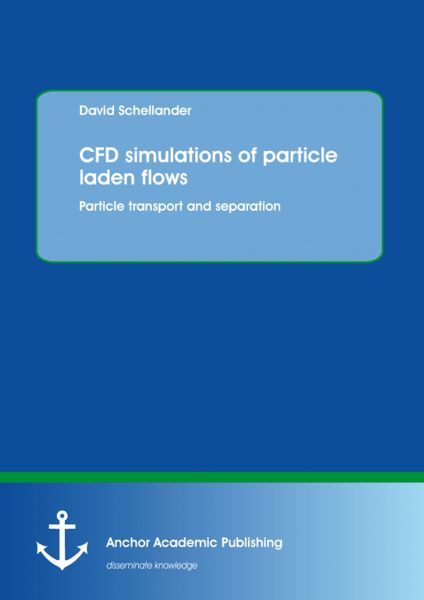CFD simulations of particle laden flows: Particle transport and separation
This study presents the basic models for discrete and continuous particle laden flow simulation. An overview of the two main approaches, the Lagrangian discrete particle model and the Eulerian granular phase model is given. Moreover these two approaches are combined to a hybrid model to use the benefits of the discrete and continuous description. This safes computational time and increase the efficiency of particle laden flow simulations. Furthermore the models are extended to poly-disperse particles including a simple agglomeration model based on a population balance equation. Finally the usability of the models is shown at a pneumatic particle transport system including particle strand building and the separation of particles using an industrial cyclone.
Text Sample:
Chapter 2.7, Turbulence modeling:
In the preheating tower, the gas flow has a Reynolds number of more than Re = 105. Furthermore, the gas flow is turbulent. One problem due to computational limitations, is that the grid size must be in a range where it is not possible to resolve all turbulent scales. Hence, the turbulence of the gas phase is commonly represented by turbulence models to account for the influence of unresolved eddies in the mean flow. Turbulence models that are commonly used in industrial cases are the Reynolds Averaged Navier-Stokes (RANS) models (for example ke, RSM) because they include the influence of small vortices. In literature there are two basic approaches to extend single phase RANS to multiphase flows. One approach is the mixture approach and the second one is the dispersed approach. In the mixture approach a dilute to medium density particulate flow is assumed and for the dispersed approach a dilute particulate flow is assumed. Furthermore, in dense particulate flow regimes, the gas flow through the particles is assumed to be laminar. The mixture model is a good choice if the density ratio between the phases is around one [ANSYS, 2009], which is not the case in our flow situation. Consequently, in this work we used the dispersed RANS model as turbulence model, because it is important to model the physics of turbulence in dispersed regions correctly.
2.8, Boundary Conditions:
The main challenge at the wall is to calculate the shear stresses t kcs and the flux of fluctuation energy, q, from the wall into the domain. Particles hitting a wall can either slide, roll or are directly reflected back. Johnson and Jackson [1987] presented a model, which is nowadays commonly used for simulations. However, this model ignores the fact that a granular medium sliding at a wall can only exert a shear stress limited by Coulumbs law to the wall. This, in term, implies that these boundary conditions overestimate t kcs and q in rapid granular flows. This is recognized by the model of Jenkins and Louge [1997]. The paper of Schneiderbauer et al. [2012b] is a generalization of the boundary conditions derived in Jenkins and Louge [1997]. The new set of boundary conditions for the Eulerian phase described in Schneiderbauer et al. [2012b] has been applied during this survey. In the case of the preheating tower, simulating wall bounded particle conveying is crucial because of the high impact of walls on strand formated particle-laden flows. Obviously, this requires a thorough modelling of particle-wall interactions. Hence this new boundary condition should be used for the simulations.
Dr. David Schellander was born on 17th of December 1983 in Hall in Tirol in Austria. After his study of mechatronics he wrote his PhD-thesis at the Johannes Kepler University in Linz in the field of particle laden flow simulations. During his study he worked several years in the topic of particle flows and pneumatic particle laden flows. After finishing his PhD-thesis he used his expert knowledge in particle laden flow simulations to improve the quality of CFD simulation codes.
Versandkostenfreie Lieferung! (eBook-Download)
Als Sofort-Download verfügbar
- Artikel-Nr.: SW9783954896714
- Artikelnummer SW9783954896714
-
Autor
David Schellander
- Wasserzeichen ja
- Verlag Anchor Academic Publishing
- Seitenzahl 152
- Veröffentlichung 01.02.2014
- Barrierefreiheit
- ISBN 9783954896714

